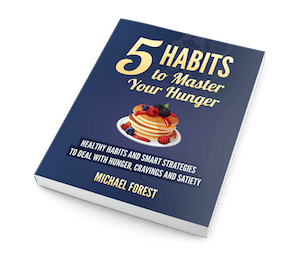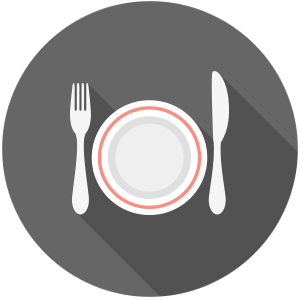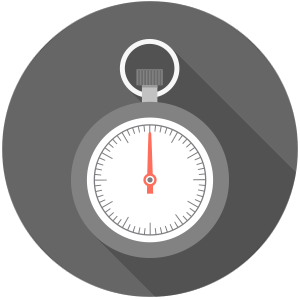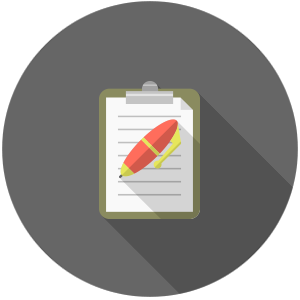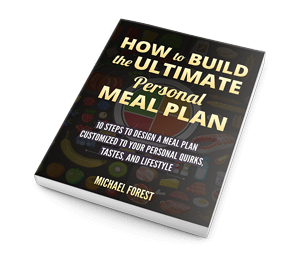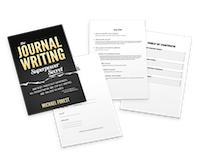Implement well-timed calorie spikes (cheats).

Cheat days, refeeds, and spikes oh my!
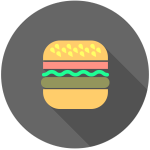 This is the fun one. (To put it mildly.)
This is the fun one. (To put it mildly.)
There are two tricks to calorie spikes:
- Knowing WHEN to implement a calorie spike.
- Being in the right mindset, so you don’t play head games with yourself.
(A third, somewhat less important one, is knowing what to eat to really satisfy cravings, fill up your energy stores, and feel great the next day. But this mostly just comes with time.)
Here’s the oversimplified explanation for spikes:
Research shows that prolonged dieting (that is, a prolonged caloric deficit, or eating less energy than you burn) leads to a decreased metabolism. That’s life. But a calorie spike can bring it back up. This is because as you diet a hormone called leptin decreases over time. When this happens, hunger goes up, energy drops, and fat burning slows down—a good recipe for frustration and weight gain.
A well-timed calorie spike, however, brings leptin back up to normal or above, so that your body can get right back to fat burning. Sounds good, right? Oho. But wait, there’s more. The spike – but again, this is only if it’s well timed – won’t store the excess calories as fat, but rather as glycogen stores (glycogen = carbohydrate stored in the muscle). If it is well-timed, you’ll actually “over” replenish your glycogen stores, effectively giving you lots and lots of energy for whatever exercise you’re doing. (Um, you should be exercising.)
Spike days and cheat days and so on are becoming more and more common in the fitness industry, as more and more people discover their benefits. My own knowledge here comes from reading some of the actual research on leptin (which is fascinating), as well as information from Lyle McDonald, from Scott Abel, and just plain experimenting and having fun with it.
Scott Abel’s work is interesting because he has been implementing insane calorie spikes for decades, which is far longer than the rest of the industry. He has a “Cycle Diet” video course on Udemy that I helped structure and put together, and it goes into some of his ideas, but I’ve also been coached by him and have learned from first-hand experience (both with his protocols and with my own experimentation).
Unlike other people in the industry, instead of “forcing” the body into being ready for a spike by using things like low-carb diets and glycogen depletion workouts, Scott gently coaxes and coaxes the body, and combines that with correctly reading the signals the body gives off, in order to tell you when it needs a spike.
Your body telling you when it is ready is very different from you trying to tell it. Scott also has a great quote about this:
The gist is that when a body reacts, it reacts against you. It compensates metabolically with down-regulation, makes you feel tired, that kind of thing. But when you coax it, it responds in the direction you want it to.
Overall, I prefer Scott’s method. It’s “harder” to get right, and requires more expertise and experience (often he recommends a coach), and even some trial and error, but in the end, I think it’s the better way for long term sustainability.
First, you have to be in a caloric deficit for *some* amount of time. How much time depends on the individual. I’ll get into that in a second. But for now, I want to stress that you cannot just randomly decide, “Hey, the guy on the Internet said calorie spikes are good! Time to eat a bunch of cookies! Nom nom nom.”
No.
Just. . . ugh, no.
That’s not how it works. Even if you don’t want to lose weight, and you want to use calorie spikes to maintain your current weight, you have to be in a caloric deficit the rest of the week. (This is actually very easy. The regular meals, and strategic spike meals means that hormonally, metabolically, and habitually you just don’t experience unwanted hunger, despite technically being in a deficit.[1])
However, I assume a lot of people reading this are dieting or thinking about dieting (or whatever), and therefore want to lose weight. And if you want to lose weight or are dieting, I’m going to assume you’re already in a caloric deficit.
There are three main factors that determine when you’re ready for a spike: 1) hunger, 2) energy levels, and 3) rate of weight loss.
One of the big “truths” about hunger is that it is cumulative. It “adds up” over time, as it were, especially as your body composition changes and you lose those previously reliable back-up energy stores (i.e. your excess fat).
What I mean by this is that, on the first day of a diet you’re not gonna be that hungry in the true sense of the word, and when you do eat a meal, you immediately feel very full again.[2]
By contrast, on something like the sixth week of your diet, you may well get to a point where even immediately after eating you think, “Argh, that didn’t help at all.” That is, right after eating your stomach still feels empty and grumbly, and you still have low energy. (This is why I recommend using a feeding window + larger meals. Larger meals allow you to “last” longer into a diet than you otherwise would, all while still getting that feeling of fullness.
So now it’s time for a spike??
Nope. Not yet.
Hunger usually builds up gradually. A good sign is when you get to a point where you feel literally “empty.” (You’re not “literally” empty, of course, but yes, you really do feel as though that it is literally the case.) You also feel as though your meals don’t do a darn thing in terms of filling you up.
In the words of Scott Abel: “When you suddenly feel like you can eat the ass-end of a rhinoceros, that’s about when you’re ready.”
Also note that this feeling of insatiable hunger ends up being true. Once you get to the spike meal, you realize you can eat and eat without feeling full. This is because you have so many energy stores that need replenishment and even super-replenishment. It takes a lot of food because you’ve primed your body to need a lot of food.
Your energy levels are easier to gauge if you’re working out regularly, because it’s less mental energy (though there is a bit of that) and more about muscle energy (this is literally true, but you’ll be able to feel it in this way as well).
But put simply, energy levels are a lot like hunger in that they’re cumulative. Your energy and your ability to work out will gradually decrease as you diet for a long period of time. That’s okay. Some drop in performance and strength is expected as you diet.
What you’re waiting for is, in addition to the gradual decrease, you should eventually experience a big sudden plummet.
It goes like this:
Your energy in the gym is going down a bit, down a bit, down a bit—then suddenly WHAMMO! it’s as though you’ve hit rock bottom and you ain’t got nothin’ to give in the gym. You never get a pump. The amount you’re lifting is way down. You feel like crap.
That’s the kind of energy drop I’m talking about. (And yes, because the effects are cumulative, it even happens when you’re on a moderate carb diet. It just takes time. Remember, we’re not forcing the body via low carbs or depletion workouts. We’re coaxing it.)
Basically you’re waiting for weight loss to stall, which is a sign of leptin being out of whack and in need of a reset. So if you’re experiencing the above two factors, and if your weight loss has stalled at about the same time, then it’s probably time for a spike meal.
Also, paradoxically, your weight can start plummeting too fast all of a sudden, in which you can also implement a spike. Partly this is because hey, why not, right? If you’re plummeting, might as well slow things down and enjoy it. And partly it’s to prevent muscle loss.
If you’re losing one or two pounds per week, uh, it’s not time for a spike.You’re still burning fat just fine. (Obviously, this is assuming you're in a reasonable caloric deficit. If you're losing one to two pounds per week because you're only eating 1,000 calories each day, then sorry: you're doing it wrong, and you're going to mess everything up. Stop it.)
So… how do I do this “spike” thing?
It’s party time, basically.
For your first time, begin with just a big single meal (but I do mean BIG). Then if that goes well, move on to a five-hour spike (basically, a half day). And then if that goes well, you can move to a full day.
Don’t progress to the next “level” unless you really feel the previous one went well. Depending on the effect the spike has, it’s up to you whether you 1) hold off on another spike altogether, or 2) stay at the same level, or 3) move “up” a level to a bigger spike. I’ll talk about how to judge whether it went well in a bit.
First, I want to say that for the spike itself. . . don’t count calories, don’t focus on certain types of foods (except insofar as eat the foods you want), but also don’t eat to the point of pain or discomfort. In other words, don’t worry too much about eating “in moderation,” but also don’t be a total dummy such that you eat until it hurts.
If you’ve paid attention to my above instructions on when to implement a spike meal, you should find yourself able to just eat and eat and eat. Again, you have a lot of energy stores to replenish, so you should feel like you need too eat a lot.
Note, however, that this is not emotional binging.
You have to be in the right “headspace” for this to work.
Some people can’t do it because of where their head is. If you’re an emotional eater or you’ve suffered from a serious eating disorder in the past, this type of strategy isn’t for you.
When you do the spike, you have to actually feel as though you’re physically filling up energy stores.
Remember how I said that before you implement a spike meal you should actually feel as though you’re running on empty? Like your limbs literally feel “empty”? And how even right after you eat a meal, it feels like you didn’t eat anything at all?
Well, during the spike you should almost feel as though at first you still cannot quite fill up your energy stores. You just eat and eat, but for a while you feel “bottomless” and it takes awhile before finally towards the end you actually do seem to fill up and start feeling “full” again.
And once you do reach that point where you’re finally actually filling up on energy, that’s when it’s time to stop.
If you weigh yourself, you should lose all the weight within six days of the spike, and possibly even more. So for example if you weigh in on spike day at 170, then gain 10 lbs of water weight that day (which is entirely possible[3]), you should be back down to 170 again, or even lower, six days later.
In the mirror you should look a bit bigger at first, maybe with some loss of muscle definition for the first few days after the spike, but by about four days after you shouldn’t really be able to tell the difference, and after six days you should be sure that you definitely look the same if not better.
In terms of how you look, you will probably get what Lyle McDonald calls “spillover.” He considers this kind of a bad thing, but I think it’s fine. This is because I’m not as strict as him with only low-fat foods and trying to get in exactly X grams of carbs. This is because a spike meal for me is also a mental thing, and I suspect that filling up on fats has benefits too, since a spike is more than just about filling glycogen. (So definitely eat those real cookies and ice cream, and not that low-fat garbage.)
Note also that this spillover (which is mostly just water, so chill out) can be the day after the spike, as you might expect, but often it’ll be two days after the spike. That’s just digestion taking its time. This almost always happens with me, though I’ve never seen anyone else really talk about it.
This means that many times you’ll actually look better the day immediately after a spike, because your muscles are fuller, but they’re not washed out yet with water weight. Then the second day after is when you’ll look like you’ve gained water weight and your muscles are all washed out and ooh boo hoo hoo *blubber* *sob*.
Again, this is just your digestion and body doing its thing in its own sweet time.
The third day should pretty much always be better than the second day, and as I said earlier, by the fourth day you should look pretty darn close to your pre-spike physique.
(Note, in terms of how you look, all this is moot if you’re above 20% bodyfat for men, and maybe 30-35% for women. If you can’t really see any difference before or after a spike because you still have a bunch of fat that makes it impossible to judge seeing “more” or “less” muscle definition, just go by the scale. Duh. Also, if you’re above 20% bodyfat, you’ll need less spikes than someone who’s already been dieting for a long period of time. This seems like a bummer because spikes are fun, but keep in mind it’s because your current rate of weight loss should already be pretty good and shouldn’t be stalling yet.)
You have to be able to relax and enjoy the spike, without guilt, and you have to be able to get back on diet as soon as it’s over, and you have to then as objectively as possible determine whether you really do need another one in the near future.
This becomes easier with time, as you can see that yes, the water weight does always come off quite quickly, and yes, it actually does seem to speed up your metabolism and your overall rate of fat-loss.
This will depend on your goals and how things are going. Some basics:
If you’re dieting down:
If you’re dieting down to really low bodyfat levels, chances are you shouldn’t have a spike more than once per 1.5 weeks, and usually it should be even less than that.
I know a lot of books recommend a cheat day every single week when dieting down. For many people, though, that will be too often, unless you’re really limiting your spikes. It’s too often for me, for example. But limiting the spike itself is totally lame, and also defeats the purpose, both physically and mentally. So I recommend holding off, and then letting a spike actually do what it’s supposed to do.
I promise you’ll be fine as long as you promise yourself not to have another spike until you clearly and obviously are at a better spot than you were when you had your previous one. For example: you had a spike at 170 lbs, gained 10 lbs of water weight, and have since lost those 10 lbs of water and an additional 2 lbs and wow you look really good in the mirror. If that’s you, things definitely went well. You’re now at 168. Have another spike, if you feel you need it.
This is not that easy. It takes trial and error. And you might need a diet coach if you find the water weight and the desire for a spike and so on is messing too much with your head.
If you want to maintain:
Some people eat at a caloric deficit and then spike as a means of controlling hunger. When I maintain, a combination of regular planned diet meals at the same times each day, with a few spike meals here and there, are how I do it. (It’s also how I’d lose weight, for that matter, but the regularity of the spike meals would go waaayy down.)
In the case of people looking to maintain or slowly improve, you should still get back to very near your original weight before a spike. Theoretically, some weeks you should be at the same weight, some weeks a little below, and some weeks a little above. That’s fine too. Go by the mirror, and pay attention to the whole context of what your body is telling you (hunger, how you’re feeling in the gym, etc.). Watch the longterm trend more than fluctuations week to week.
Remember that if you want to implement spikes at all, you do have to be pretty strict with your diet on non-spike days. Some people don’t mind that or even find it easy, but some people prefer more relaxation and little cheats all throughout the week. Just try to be honest with what works best for you.
Enjoying the Guide?
Get the Revised and Expanded Edition (available now on Amazon)
New Sections
3 Key Principles (...About Your Hunger and Cravings)
"Am I In the 'Sweet Spot' of Hunger?" Assessment Guide
8 Factors Affecting Your Ability to Assess Your Own Hunger
"Do I Need a Cheat Meal?" Assessment Guide
Introduction.
Dealing strategically with hunger, cravings, and metabolic compensation.
Habit 1.
Eat in such a way that you train both your stomach and mind to only be hungry when it’s time to eat.
Habit 2.
Pick (and combine) foods that satiate YOU.
